Abstract
Numerous specialists and academics have backed the improved physicochemical characteristics of metal substrate (Ag, Au) based composite nanoparticles for a number of applications, including pharmaceuticals, optoelectronics, and environmental impact. Insights of Ag and Au NPs-based nanomaterials will be discussed, as well as important production, physicochemical, and biotechnological characteristics. The plasmon capacities of Ag and Au NPs, along with their customisable form, scale, and surface modification could be described by specified geometries and constituent contents. It was revealed that interaction dynamics of Ag and Au implanted nanomaterials with dopants/defects ratios seem to be more effective in stimulating pathogens by interrupting biochemical reactions. As a result, we focus on defect science in Ag and Au-based nanoscale materials, taking into account surface morphology, ionic packing, and chemical phase assessment. This chapter will cover the important optical, geometrical, and physicochemical features of Ag and Au nanomaterials, and their pharmacological significance.
1. Introduction
Inorganic noble nanomaterials have caught scientist’s interest due to their potential applications in biology, semiconductors, optoelectronic devices, and pharmacology, resulting in their extraordinary features at nanoscale [1,2,3,4]. Nanocomposites have enabled new novel applications, particularly in highly combined nanomaterials, because their characteristics are dependent on quantities, texture, and geometry. Plasmon nanoparticles, especially Au and Ag NPs, have gained prominence in recent years due to their potential usefulness in precision medicine. The metal and metal-based hybrid nanostructures are designed with suitable organic and inorganic hosts or substrates. Such hybrid metamaterials were found to be effective and reliable for multifunctional biomedical uses, and thus, nanosystem are used for hybrid nano materials. This includes dendrimers, 2D carbon allotropes, and other desired supported chemical compositions shown to be chemically stable and durable nanosystems. The surface modifications and elemental combinations provide exceptional catalytic actions in a designed nanosystem that could be implemented for wider purposes. Despite the fact that Ag NPs have powerful antimicrobial and cytotoxic effects, Au NPs are thought to be more biocompatible for a number of combinatorial sensors [5,6]. Their advantages complement the well-tunable plasmonic capabilities of Au-based nanomaterials, which have been extensively studied in medical applications such as bioimaging, X-ray computed tomography contrast, and photodynamic treatment (PDT). Physical and chemical reactivity (especially the surface plasmon spectrum) of mixed NPs can be changed methodically as a function of NP composition. The three major strategies to manufacture Ag and Au-based nanomaterials are the morphological, chemical, and biological approaches; nevertheless, the chemical route is the most popular and well-known. The chemical production of NPs produces nanoparticles that are either less dangerous or poisonous than bulk compounds. Due to the delayed release of chemicals used in formulations, chemical-based formulations have limitations in cellular applications [5,7]. Toxicities to cells are also a problem with chemical-based techniques. The development and usage of effective alternatives, such as nanoparticles manufactured from plant extracts, may result in a reduction in harmful effects. Plant materials have active pharmacological components that can act as capping agents for NPs, increasing their therapeutic potency while also acting as reducing agents. Previous biomedical research that used the photoluminescence of Au nanostructures primarily focused on bioimaging. High temperature, for instance, dramatically increased the near-infrared luminescence of mercaptosuccinic acid and tiopronin-protected Au NPs by converting transient non-luminescent groups into stable luminescent units having narrow density [8,9]. In single-cell imaging, PEGylation of Au NPs enhanced cytoplasmic permeability, and these PEGylated Au NPs can reach within the nucleus [10]. However, as the diameter of the metallic core shrinks, the surface-to-core metal atom ratios increase, leading to a significant increase in the quantum yield. The nanoclusters’ small size and high emission in the near-infrared spectrum suggested that they could be helpful diagnostic reagents in fluorescent bioimaging. Furthermore, convenient techniques for inserting specific probe molecules onto metallic nanocluster surfaces are provided by rich surface chemistry.
It is possible that decreasing Ag nanoparticles to the sub-nanometer range may greatly boost Ag’s antibacterial therapeutic capabilities due to the significantly larger surface-to-volume ratio. Furthermore, these Ag nanoparticles with good structures can provide additional benefits such as easy post-functionalization, high stability, and excellent and versatile photoluminescence, not to mention that the conclusive main constituents can provide an adequate basis for establishing the link between Ag nanostructures and their antimicrobial frameworks. The studies on Ag NPs supported hydrogel that demonstrated improved antibacterial activity against both Gram-negative and Gram-positive bacteria were published by Liu et al. [11]. Because of its Ag species-specific controlled release capabilities, it demonstrated hard bactericidal performance compared to pure Ag nanostructures. Yuan et al. [12] developed a range of water-soluble thiolate Ag nanostructures with strong luminescence and tunable emissions, and these NPs have improved antibacterial activity against the multidrug-resistant bacterium Pseudomonas aeruginosa by producing a high amount of intracellular ROS. In another study, researchers discovered that different charge configurations can have a significant impact on antibacterial activities. Antibacterial testing demonstrated that Ag+ enriched NPs exhibited substantially better antibacterial activity than pure Ag NPs against Gram-negative (P. aeruginosa and E. coli) and Gram-positive (B. subtilis and S. aureus) microorganisms [13]. In this chapter, we provide a basic overview of Ag and Au-based nanostructures, comprising production processes, physical elements, and their biotechnological uses. The value of Ag and Au-assisted nanosystems in nanomedicine and health sciences has been thoroughly studied, with literature that is extremely helpful in comprehending the significance of these metallic nanoparticles.
2. Engineering of Plasmon Based Ag/Au Nanostructures
Designing and fabrication techniques were found to be more effective to alter the nanostructures’ shape and size especially for the targeted objects. In recent years, inorganic and organic-based nanoscale materials have been broadly applied in medical tools devices. Ag and Au-based nanosystems are among the fundamental themes of nanostructured research. Different scientific techniques for designing and developing noble metal nanoparticles with controllable geometries and electrical configurations have been investigated [14,15]. However, transmission electron microscopy and surface scanning microscopy have long been used to investigate the formation of nanoparticles caused by the breakdown of strong energy or electron beam irradiations. Chemical, physical, and biological creations are all methods for creating Ag and Au-based nanotechnologies [16]. Currently, breakthroughs in nanoscale materials technologies for producing nanomaterials with different antimicrobial features are emerging, principally using microbiological and biochemical raw materials. Such essential strategies are considered here for the purposes of production and engineering in order to improve antimicrobial and biological implications.
2.1. Morphology and Surface Control of Ag and Au Nanosystems
2.1.1. Chemical Approaches (Sol-Gel, Hydrothermal, and Co-Precipitation Method)
The sol-gel strategy is a modest technology that generates cost-effective things with the correct molecular structures when using chemical pathways. This approach’s framework can be used in a range of fields, including semiconductors, lasers, aerospace, and the power industry. The sol-gel method involves repairing a gel, which eliminates the requirement for atomic diffusion and improves precision [17]. The resulting gel is submitted to solid-state estimates after hydrolysis and condensation, and the result is formed as a mixture of compatible preparations. The alkoxides are frequently mixed under the action of alcohol to create multi-component oxides. In a few cases, additives like acetates could be utilized instead of alkoxides. Water for disintegration, ethanol, pH proportion of alkoxides, and calibrated heat are all required for the sol-gel synthesis.
Ag/Au-based nanostructures have now become economically viable due to the close relationship between plasmonic properties and controllable size and form. Traditional methods, such as nanosuspension and thermal destruction, necessitate a lengthy procedure as well as extreme heat. The particles can be crystallized by a solvothermal procedure at a required temperature in a covered vessel with a high vapor pressure by combining several wet chemical treatments. Compared to other methods, the hydrothermal method creates particles with a crystalline structure. The solvothermal method was also used to produce the deformation of particular crystalline grains, making it the most dynamic method for creating ultra-crystalline nanoparticles [18,19].
The simplest and most efficient approach for creating Ag and Au nanoparticles is co-precipitation. Reaction kinetics, on the other hand, can govern the crystal’s development, restricting the size of the particles. The shape and surface characteristics of nanoparticles can be modified during the production process to satisfy specific demands. The co-precipitation approach is another excellent strategy for manufacturing high production with homogeneous sizes nanostructures [20].
2.1.2. Green Synthesis
However, traditional plasmon-based nanostructure manufacturing strategies have numerous drawbacks. Moreover, the production of nanomaterials has required the use of a variety of sustainable resources, including biological beings and plants. Specialists are becoming increasingly interested in the biosynthesis of nanoparticles from plant sources. For a short time, a plant infusion reduces metallic ions while simultaneously increasing the creation of nanosized particles. The species of plant and phytoconstituents influence the amount of time it takes for nanocrystals to form [21].
2.2. Ag and Au Doped Metal-Oxides Nanostructures
Metal and metal oxide nanoparticles (NPs) have gained a lot of research attention due to their exceptional chemical, optoelectronic, and dynamical properties. They may now be found in a wide range of industrial, medical, agricultural, and biotechnological uses, with new ones being created all the time [6,22]. Current immaculate metal and metal oxide NP manufacturing techniques entail reducing and anchoring active components that are toxic to humans and other animals at several taxonomic levels. Experts are now looking at alternative “green synthesis” methods to reduce or eliminate toxic chemicals during the production of NPs. In various research investigations published in the literature, scientists used a single nanoparticle in biomedical applications. Because there are few types of study in the field, the nanostructures used by medical researchers are confined to solid Ag and Au. In the healthcare profession, Ag and Au doped CuO, Al2O3, SiO2, TiO2, and nanostructures have been used [3,18]. In every previous study, the essential features of metal-doped semiconductors could be altered by doping metal ions into the host metal-oxides at varying dosages. Doped materials such as Ag and Au affect the absorbance bands and the free electron combination action of semiconductors by causing crystal defects and Vo. These imperfection levels are critical for increasing the physicochemical, refractive, and antibacterial properties of semiconductor crystal structures. Numerous experiments have been conducted on Ag, Au, Pt, and anion-doped semiconductor nanomaterials to alter their crystallographic pattern in order to demonstrate the fundamental stabilities of electronic crystals [23]. In the pharmaceutical and biomedical sectors, metallic and metal-doped metal oxides, mainly plasmon-doped nanomaterials, have been actively explored for therapeutic systems.
2.3. Enhancement in Plasmon of Au and Au for Biomedical Aspects
Whenever nanostructures are triggered with a light noble metal, the surface plasmon resonance (SPR) induces strong absorption in the visible light spectrum. Noble metal nanoparticles absorb photons intensely and, thanks to their plasmonic properties, may squeeze light into the nanoscale [3,7]. The ability to influence and transmit light at the nanoscale scale using noble metal nanoparticles has given rise to the new field of plasmonics. Noble metal nanocrystals have a wide range of applications in fields such as surface-enhanced Raman spectroscopy, near-field high-resolution optical microscopy, biodiagnostics, nanophotonics, photonic biosensors, and processing, which has inspired plasmonics research. A phenomenon known as localized surface plasmon resonance occurs when light interacts with conductive nanoparticles with wavelengths shorter than the irradiation wavelength. It is amazing to see how the antibacterial properties of Ag or Au NPs change as a result of the plasmon resonance phenomena [23,24]. Metal–vapor synthesis (MVS) is employed by Alexander Yu et al. [25] to manufacture silver-based dressings and their antibacterial effects, according to an SPR-based study. Ag NPs-based dressings have antibacterial properties against Gram-positive and Gram-negative microorganisms like (Streptococcus aureus, Streptococcus haemolyticus, Pseudomonas aeruginosa, Klebsiella pneumoniae), Escherichia coli, and Moraxella spp.) The colony-forming unit (CFU) reduction % is found as: Staphylococcus aureus (95%), Staphylococcus haemolyticus (34%), Pseudomonas aeruginosa (58%), Klebsiella pneumoniae (68%), Escherichia coli (64%), Moraxella spp. (55%), and Staphylococcus aureus (95%).
Using a chosen aptamer as the recognition element, Bai et al. demonstrated an SPR-induced biosensor for the sensing of avian influenza virus (AIV) H5N1 (Figure 1). The detecting sensor was created using streptavidin–biotin-binding to immobilize biotinylated aptamer across a streptavidin-loaded Au NPs surface. The device has a linear AIV detection range of 0.128 to 1.28 HAU (R2 = 0.99) and a 1.5 h test time, and it could be used in chicken swab specimens. An inhibitory assay using hemagglutinin (HA) protein placed over the sensor chip to identify entire viruses was used to quantitate AIV H1N1 and H3N2.
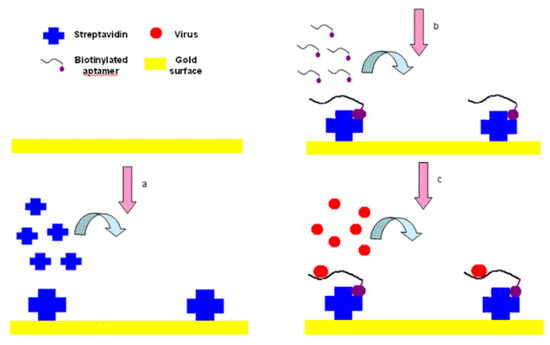
Figure 1.
(a) SPR based biosensor for recognition of AIV H5N1: (a) streptavidin control; (b) biotinylated aptamer control; (c) virus recognition [26]. (Reprinted with permission from ref. [26]; copyright: 2012, MDPI).
3. Fundamental Characteristics towards Biomedical Applications
In biomedical engineering, Ag and Au at nanoscale ranges were fabricated and applied along with other 1D, 2D, and 0D substances. In the 1870s, silver and gold compositions became widely used. However, several confirmations of silver compounds’ antiviral, antibacterial, and anti-inflammatory properties have been published since then [6]. Antibiotics, which have more potent antibacterial properties, have greatly diminished interest in silver’s therapeutic properties. Nonetheless, by the end of the twentieth century, widespread usage of antibiotics had resulted in a number of faults, and Ag/Au combinations were still being studied and used extensively. Ag and Au’s nanostructures have a surface and electronic configuration that makes them attractive candidates for better physicochemical reactivity and selectivity among metallic nanomaterials. Due to their SPR and controlled morphologies, several study discoveries have been studied specifically for these two noble metals and their complex compounds, including biological, electrical, and photovoltaic claims. The dimensional fluctuations of the excited electrons on the particle surfaces are moderated by the regulated plasmon-induced light intensity, and thus, the functionalities of the catalytic activities are controlled. This spectrum notion is particularly useful for polymeric nanosystems, such as metal oxides, organic complexes, and synthetic polymer frameworks. By using aqueous Zingiber officinale extract as a reducing agent, Mohapatra et al. [27] developed a cost-effective synthesis technique for growing Ag NPs at room temperature. Optical absorption measurements were used to study the SPR spectra of Ag structures, and sunlight irradiation was used to produce red-shifted intensities. Due to the involvement of SPR intensity, the biosynthesized Ag NPs had a better antibacterial impact on the aquatic bacterium Escherichia coli. In the visible range, Au NPs display the SPR phenomenon which is studied at 520 nm. The metal particle size has an impact on the SPR band. (Figure 2) [28]. The Au NPs having narrow size (less than 10 nm) are noticeably damped due to phase changes which possess collective motions of free electrons on the surface compared to bulk objects. Such changes in particle sizes also affect the catalytic activities, in particular, biomedical applications like drug delivery, cancer treatments, etc.
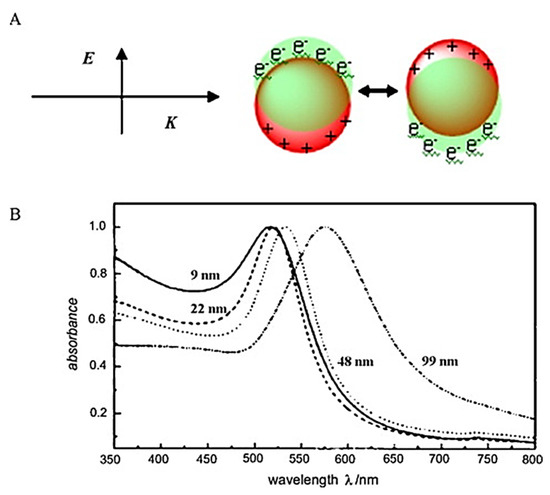
Figure 2.
SPR studies of Au NPs: (A) SPR generation on particle surface and (B) SPR bands of Au NPs with different sizes [28]. (Reprinted with permission from ref. [28]; copyright: 2010, Elsevier Ltd.).
Metallic NPs, on the other hand, have different work functions than metal-oxides due to their oxidation states. As a result, numerous techniques such as XRD, XPS, EDS, and others might be used to determine the comprehensive information of the generated nanoparticles and their complexity. The elemental oxidation phase and their compositions in planned nanocomposites have been determined using XPS, which has proven to be a trustworthy approach. After synthesis, the specific binding energy aids in determining the pure metallic and metal oxide products. The variation in binding energies aids in identifying the specific elements present in nanomaterials. In general, the binding energy peaks for Au 4f locate at around 84.1 and 87.8 eV, while the Ag 3d peak locates at around 368.2 and 374.2 eV (Figure 3). The energy differences for the 4f7/2 and 4f5/2 peaks of Au are determined around 3.7 eV and for the 3d5/2 and 3d3/2 of Ag, 6.0 eV. These binding energies are found to be identical to the Au and Ag neutral atoms [29]. Thus, this technique is precisely used to identify the chemical states and atomic ratios of the elements.
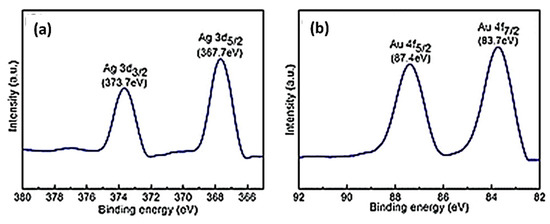
Figure 3.
Binding energies for the Ag (a) and Au NPs (b) by XPS [29]. (Reprinted with permission from ref. [29]; copyright: 2018, RSC).
The element percentage or ratios could be well determined by using the XPS in the case of multicomponent nanostructures. Alternatively, XPS techniques could be used to detect Au and its oxide phases, which display discrete binding energies for specific structures. Other techniques, such as Raman, can be used to analyse the nano-based materials that are connected with Au and Ag and their supported substrates or nanoparticles.
3.1. Bandgap Engineering and Optical Responses for Improved Catalytic Action
The bandgap-change alterations have been determined using techniques such as PL and UV–VIS spectroscopy. To attain the best bandgap values for ZnO, Ag-doped ZnO and pure ZnO were created. Optical absorption spectroscopy, shown in Figure 4, is a fundamental characterization for observing a bandgap energy shift in produced products. Ag NPs show an absorption band around 420 nm, which shifted in the case of Ag-doped ZnO showing broadband from the 400–600 nm region. However, the bandgap values were also found to be changed for doped Ag NPs with the ZnO NPs (ZnO: 3.20 eV and Ag/ZnO: 2.95 eV, respectively. Adjustable bandgap values aid in the control of charge transfer in semiconductors [30,31].
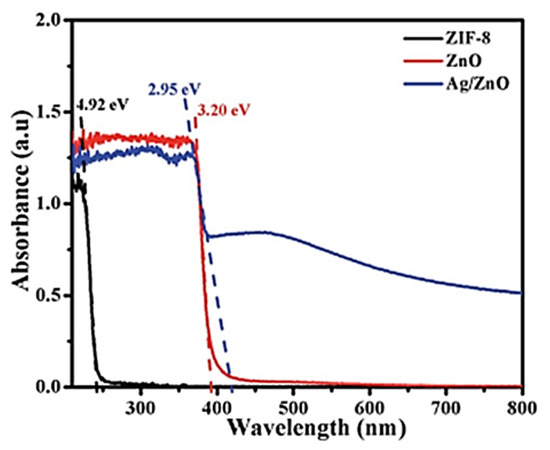
Figure 4.
Optical absorption profile; Bandgap values of unloaded ZnO and Ag-ZnO NPs [31]. (Reprinted with permission from ref. [31]; copyright: 2018, RSC).
Photoluminescence (PL) spectroscopic seems to be another method for estimating or evaluating the photon energy of plasmon semiconductors. This method also aids in the identification of communities of a created defect in semiconducting nanostructures linked to plasmon elements. Figure 5 displays a general idea of the number of defects inside host materials such as ZnO semiconductors doped by Rb rare ions (at the variable concentrations of 7, 12, and 17 w%). An increasing or decreasing trend in PL intensity revealed that imperfections are created in the lattice of the host.
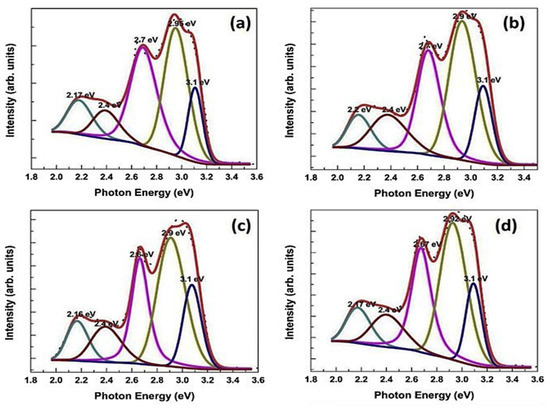
Figure 5.
PL profile of ZnO and ZnO: Rb: (a) ZnO, (b) ZnO: Rb at 7 mol%, (c) 12 mol%, and (d) 17 mol% [30]. (Reprinted with permission from ref. [30]; copyright: 2020, Elsevier Ltd.).
3.2. Role of Chemical Compositions, Surface, and Defects to Improve the Catalytic Functions
The pure and metal-doped host semiconducting nanomaterials are widely appreciated to achieve potential applications in the area of medical science and technologies. To change the surface structures and the electronic band positions, suitable cations such as Au and Ag are incorporated into the semiconductors (ZnO, CuO, TiO2, etc.), resulting in optimum bandgap values which make them a much-desired nanosystem for controlled electron-hole pair mechanism. However, the creation of multiple defects levels is also involved to regulate the charge transport mechanism into the doped semiconducting nanomaterials. Much recent research has concentrated on developing nanomaterials for application as potential antimicrobial substances by integrating nanomaterial science techniques with the natural antimicrobial effect of inorganic metal oxides [5,6]. Metal oxides are a good alternative to conventional antibacterial techniques because most metal oxides are non-toxic. Promod Kumar et al. [32] have altered the surface and band structures of CdO nanostructures by doping the Zn ions at a certain concentration which created lots of defective centers in the host lattices. The defects ion effectively participated in the electron-hole recombination, and the antibacterial/antifungal activities were controlled. The required techniques to identify the crystalline changes as compared to pure host or metal-oxides were also explained along with the morphological observations. The dopant oxidation states and their compositional confirmation are determined by using the X-ray photoelectron technique which is often used to characterize the nanomaterials. Here, the CdO: Zn catalysts expressed a strong antibacterial and antifungal movement against Escherichia coli and Staphylococcus aureus, as well as outstanding antifungal activity against Aspergillus flavus and Fusarium verticilliodes, for unsupported CdO NPs. This is because of the indirect bandgap engineering in CdO due to dopant concentrations, as shown in Figure 6 [32].
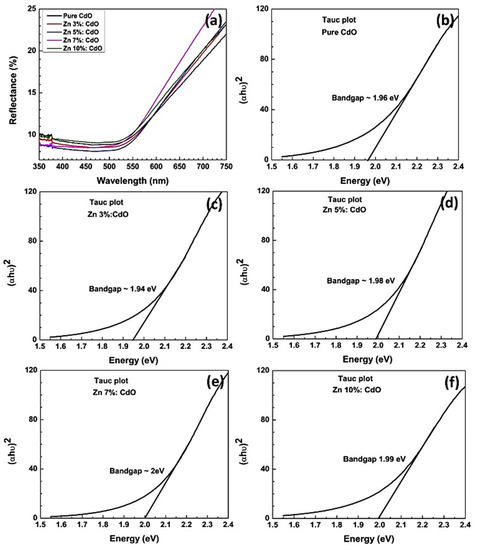
Figure 6.
(a) Diffuse reflectance profile of CdO and CdO: Zn; (b–f) bandgap values of modified CdO: Zn and CdO. [32]. (Reprinted with permission from ref. [32]; copyright: 2020, Elsevier Ltd.).
It should be highlighted that Zn works as an effective donor by substituting into Cd sites after shifting as an interstitial atom. Therefore, an increase in carrier numbers in the conduction band occurs, and Zn interstitials atoms determine the values of the bandgap. The high-energy bands in the conduction surfaces are generally filled by oxygen vacancies. Overall antimicrobial studies are displayed in Figure 7, where the metal-doped CdO are used as nanocatalysts against certain bacteria and fungi. The role of dopants at different concentrations plays a key role in cell-damaging processes during antibacterial activity.
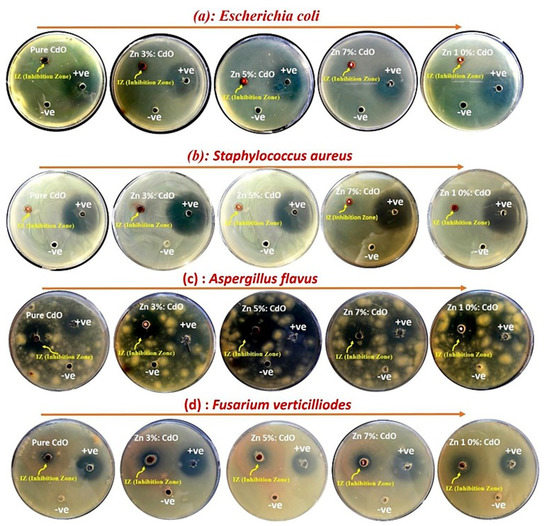
Figure 7.
Antimicrobial impacts of CdO and CdO: Zn due to change in bandgap values to (a) Escherichia coli; (b) Staphylococcus aureus; (c) Aspergillus flavus; (d) Fusarium verticilliodes [32]. (Reprinted with permission from ref. [32]; copyright: 2020, Elsevier Ltd.).
4. Antibacterial Influences of Ag and Au Based Nano-Catalysts
Nanomaterials, which contribute to a variety of biomedical purposes, are typically found in a few fundamental aspects, such as metal-oxides, metal sulfide, and metal-organic frameworks (MOFs). The main constituent of metal-based nanomaterials, often known as metallic nanocrystals, is the prior class of nanocomposites such as Ag, Au, Cu, Pt, and Pd and their derivatives. Nanocrystals (nanoparticles), such as TiO2, ZnO, AgO/Ag2O, CuO, etc. [29,30], are a different category of nanomaterials. Among these nanomaterials, doped metal/metal oxide/metal nanomaterials are another sort of class. These modified materials have improved electronic features, mechanical strength, thermochemical permanence, and larger surface area with effective optical activities. Several studies have confirmed that the defects and imperfections level of the doped ions or metals moderates the electron-hole pair recombination during the catalytic activities. Therefore, modified nanostructures or nanosystems are an effective tool in the biomedical and pharmaceutical sectors. A systematic mechanism for antibacterial activities and their proper cell damage scheme are explained in the below sections.
4.1. Schematic Antimicrobial Activities: Improved Performance
Nanomedicine, which is based on the nano idea, is gaining traction through improving diagnosis and is generating new treatment options by incorporating nanoparticles into a variety of diagnostic instruments. Owing to their photocatalysis, optical and electrical properties, plasmon metal nanoparticles (Ag, Cu, Au, and Pt) have also spurred research. Localized surface plasmon resonance is a type of resonant electron fluctuation seen in nanomaterials [7,32]. The capacity to safely combine noble metal ions into biological systems has had a profound influence on medical and biological studies. Au nanocrystals have received a lot of interest across noble nanostructured materials because of their potent toxin, ease of synthesis, and advantageous adhesion to cellular components.
The antibacterial action of the produced nanomaterials can be expressed in the form of microorganisms’ cell physiological disruption or plasma loss following nanoparticle implantation. At first, both nanomaterial’s attacks on cellular components breakdowns could influence a microbial cell’s metabolic pathway, resulting in plasma release and microbial cells apoptosis with the abnormal increase of the inhibitory procedure [33,34]. The higher the metal ion presence, the more impurities, such as oxygen vacancies, were introduced into the metal-oxides structures, as evidenced by several techniques like XRD, XPS, and EDX results [35,36]. During the VB to CB transition, metal-oxides NPs with ionic imperfections creates electron-hole pairs (e− and h+) [37]. Probably, the holes split the H2O molecules into the OH and H+ ionic species, and the liberated electrons coupled with the hydrated molecular oxygen. The anionic superoxide (O2) ions created by the molecular oxygen finally resulted in the creation of hydrogen peroxide anions (HO2) and H2O2. The H2O2 generated entered the cellular membranes and caused harm to the microorganism (Figure 8) [30]. As a result, it is worth noting that the rate of H2O2 creation rose as the quantity of electron-hole pairs was generated [38].
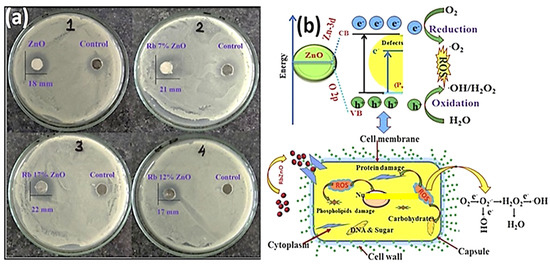
Figure 8.
Antibacterial impacts for the metal-doped metal-oxides nanomaterial against Bacillus subtilis pure ZnO (a) and (b) clear cell death representation S. Bacillus by using ZnO: Rb [30]. (Reprinted with permission from ref. [30]; copyright: 2020, Elsevier Ltd.).
4.2. Tunable Ag and Au Nanostructures and Their Biomedical Applications
Overuse of antibiotics poses a challenge to the treatment of various ailments, highlighting the significance of developing new pharmaceutical therapies. According to the scientific community, metallic-based Au and Ag NPs have been fashioned for the effective treatment of a variety of illnesses. They are thought to be beneficial due to the specific interactions of substances under or outside of the cell membrane. The increased surface area of these particles implies that they have improved membrane permeability, which also hints at the key findings. Biocompatible and durable Au NPs with increasing depth and retention impact are non-immunogenic and non-toxic, and informal deposition and diffusion for tumor treatment is a realistic approach. Numerous studies have been conducted on Au nanocomposites due to their unique medicinal potential [39].
However, nanoscopic Au and Ag NPs have indeed made a significant contribution to people’s health, both in diagnosis and in a range of diagnostic applications (Table 1) [40]. Healthcare, bioelectronics, and biomedical applications are just a few of the fields in which Au and Ag’s nanostructures have been studied intensively. The use of a new approach to creating Au and Ag monometallic nanostructures makes it simpler to close the significant reduction voltage differential between Au3+/Au ionic states [41]. Various scholars and academics have emphasized the significance of Ag NPs in the treatment of a variety of illnesses, as seen in Table 2. Ag NPs bind with bacteria and release metallic ions, deactivating biological enzymes and inhibiting barrier permeation [42].

Table 1.
Au NPs applications in biomedicine and their advantages [40].

Table 2.
Ag NPs applications for treating many infections [40].
4.3. Biomedical Applications of Ag and Au Nanostructures
Because of the rapid evolution in nanoscale manufacturing, it is critical to understand nontoxicity and its effects. Nanocomposites have been used in medicine for decades to reduce hazardous adverse effects; however, nanostructures raise some public health concerns. According to studies, the most serious problems with nanoparticles are neurologic and pulmonary impairment, cardiac troubles, and other health consequences. Several nanomaterials tend to be non-toxic, but some have been modified to be less toxic, which has beneficial medical consequences [43,44].
The effect of particles morphology on antimicrobial activity was investigated by Jo et al. [45], especially for silver nanostructures. Ag nanoparticles worked against a number of illnesses, including a soilborne fungus that hardly produces spores. According to studies, nanocrystals can successfully infiltrate and colonize plant tissue. They discovered that Ag nanoparticles have a lot of potential for minimizing fungal plant diseases that produce spores. According to their research findings, these nanomaterials may be less toxic than synthetic fungicides. In a research study, Mie et al. [46] used the disc diffusion model to investigate the antibacterial activity of their manufactured Ag NPs against eight pathogens. According to their findings, the Nanoparticles showed promising antibacterial activity against Gram-negative bacteria. As a result, the findings suggest that such Ag nanostructures could be employed for biomedical purposes. Antibacterial activities of Ag nanoparticles have been demonstrated to be comparable to those of their ionized states. Antibacterial activities of Ag nanoparticles against drug-resistant microbes have also been shown. According to the investigations, the antibacterial activity of Ag nanostructures is due to the disruption of the bacterial surface. Additionally, Jess Mauro Adolfo Villalobos Moreover, Xinglu Jiang et al. [47] structured Au-Ag NRs by Escherichia coli without surface directing agents which means surfactants and used for biomedical applications. In compared to pure Au or Ag nanoparticles, bimetallic Au–Ag nanostructures offer more encouraging development in ultrafast colorimetric detection of H2O2, photothermal therapy, and antibiotic therapy. Without the use of 3,3′,5,5′-tetramethylbenzidine (TMB) or peroxidase, Au–Ag NPs could sense H2O2. Furthermore, Au–Ag NPs could improve antibacterial action without increasing lethality, ensuring that Ag and Au can be used in health context. (Figure 9).
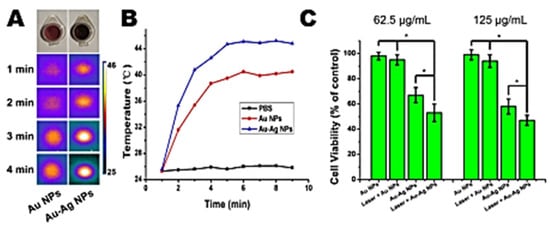
Figure 9.
Thermographic pictures of Au and Ag-Au NPs (A), Temperature graphs of phosphate buffer (PBS), Au NPs and Au-Ag NPs (B), and Cell viability by Au and Ag-Au NPs (C) [47]. (Reprinted with permission from ref. [47]; copyright: 2020, ACS.).
Hussein et al. [48] described an ecofriendly functionalization for gold-chitosan nanostructured materials (Au-CS hNPs) that used varying doses of CS as surface directing agents to investigate the functionalities of the formed Au-CS hNPs and their antibacterial properties. The proportion of CS utilized in the preparation determines its antibacterial effect (Figure 10). To make extremely reliable Au-CS hNP with compact design, regular configuration, and effective antibacterial/antifungal activities, a considerable proportion of CS is essential. As a result, while pure gold nanostructures antibacterial properties are not perfect, they can still be useful as functional mediators.
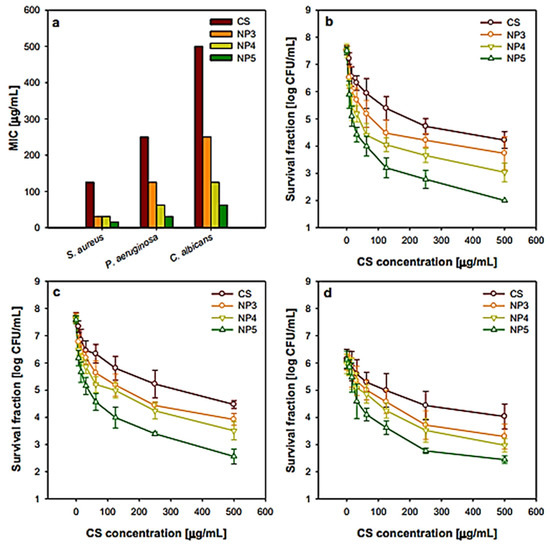
Figure 10.
MIC profile (a). CFU graph of Au-CS hNPs for S. aureus (b), P. aeruginosa (c), and C. albicans (d) [48]. (Reprinted with permission from ref. [48]; copyright: 2020, Elsevier Ltd.).
The antimicrobial activities can be boosted with surface and structural alteration. It is also revealed that the Antibiotic activity of nanostructures (Au NPs) and states have been examined, particularly several oxidation states with the Au (I & III) ions showed antimicrobial properties. Au NPs are antifungal, however, the evidence for their biocidal efficacy is mixed. It is noted that the Au NPs are either not bactericidal or just slightly bactericidal at high dosages. Nonetheless, the antibacterial effect of co-existing molecules not eliminated by Au NPs, such as gold ions, surface coating agents, and compounds used in the synthesis, could explain why Au NPs seem to be bactericidal. Au NPs can potentially operate as antibiotic transporters or delivery agents, boosting the antibiotics’ bactericidal activity [49]. However, in organic peptides and free metallic nanostructures, Bajaj et al. discovered that nanomaterials were found to be more impactful for the antibacterial and antifungal applications by attaching to the peptide’s active sites [43,44]. They discovered that cationic peptide (1-His-1-Arg-OMe)-loaded Au NPs had a lethal impact that was superior to that of conventional antibiotics. Furthermore, hybrid nanostructures are highly used in multifunctional activities in modern science and technologies by tuning the structural and surface properties [50,51]. These advanced materials have been applied for the improved work functionality and durability of the integrated circuits and nanosystems [52,53,54].
5. Conclusions and Future Prospects
Recently, nanosized Au and Ag NPs have been used in biological imaging and biomedicine, tumor targeting, and cancer therapy. Due to their narrow size, shape, strong photoluminescence, surface morphology, and improved biocompatibility, Au and Ag nanoparticles have a great deal of potential for therapeutic uses. Although Au and Ag NPs have unique physical and chemical properties, their development for targeted therapy is challenging. Therefore, the Au and Ag nanostructures have been functionalized to make them more effective and stable for medicinal capabilities. Enhancing the durability of Ag and Au nanocomposites or manufacturing highly stable Ag and Au NPs should be the next stage in the biomedical regime while designing and developing them as biomarkers or agents is still an area of interest for many scientists. Therefore, a systematic overview of Ag- and Au-based synthesis approaches, plasmonic importance, and structural modification for biomedical applications have been addressed by including suitable examples. The inorganic and organic-based Ag/Au nanomaterials are highlighted with their extraordinary optical and structural functionalities. We believe that when therapeutic processes and nanotechnology improve, gold and silver NPs will open great opportunities in the health science industry and academy.
Author Contributions
Conceptualization, G.K.I., V.K.Y., S.D.K. and S.C.; Data curation, G.K.I., S.I., C.L. and N.C., methodology, G.K.I., I.H.A., S.D.K. and S.C.; validation, K.K.Y., S.C. and V.K.Y.; formal analysis, G.K.I., S.D.K. and N.C., resources, K.K.Y., S.C. and S.I.; writing—original draft preparation, G.K.I., B.S. and S.D.K.; writing—review and editing, G.K.I., K.K.Y., B.A.M., S.I., S.C., I.H.A. and N.C.; supervision, S.D.K., N.C., I.H.A. and S.C.; project administration G.K.I., V.K.Y., K.K.Y. and N.C.; Funding acquisition, S.C., S.I. and I.H.A.; Investigation, G.K.I., N.C., B.A.M., V.K.Y. and S.C.; Software’s, G.K.I., K.K.Y. and C.L., Visualization, V.K.Y., I.H.A. and S.C. All authors have read and agreed to the published version of the manuscript.
Funding
The authors extend their appreciation to the Deanship of Scientific Research at King Khalid University for funding this work through the research groups program under grant number R.G.P. 1/105/42. The APC for this manuscript was supported by University of Oradea.
Data Availability Statement
Not available.
Acknowledgments
The authors extend their appreciation to the Deanship of Scientific Research at King Khalid University for funding this work through the research groups program under grant number R.G.P. 1/105/42. The APC for this manuscript was supported by University of Oradea. The authors are thankful to the Department of Chemistry, HVHP Institute of Post Graduate Studies and Research, Sarva Vishwavidyalaya, Kadi, Gujarat, 382715, Gujarat, India for providing the technical support.
Conflicts of Interest
The authors declare that there is no conflict of interest.
References
- Yadav, V.; Choudhary, N.; Khan, S.H.; Malik, P.; Inwati, G.; Suriyaprabha, R.; Ravi, R. Synthesis and Characterisation of Nano-Biosorbents and Their Applications for Waste Water Treatment. In Handbook of Research on Emerging Developments and Environmental Impacts of Ecological Chemistry; IGI Global: Hershey, PA, USA, 2020; Volume 16, pp. 252–290. [Google Scholar] [CrossRef]
- Malik, P.; Katyal, V.; Malik, V.; Asatkar, A.; Inwati, G.; Mukherjee, T.K. Nanobiosensors: Concepts and Variations. ISRN Nanomater. 2013, 2013, 1–9. [Google Scholar] [CrossRef]
- Inwati, G.; Rao, Y.; Singh, M. Thermodynamically induced in Situ and Tunable Cu Plasmonic Behaviour. Sci. Rep. 2018, 8, 3006. [Google Scholar] [CrossRef] [PubMed]
- Palaniappan, N.; Inwati, G.; Singh, M. Biomaterial Co-Cr-Mo Alloys Nano Coating Calcium Phosphate Orthopedic Treatment. In Proceedings of the 2nd International Conference on Structural Nano Composites (NANOSTRUC 2014), Madrid, Spain, 22 August 2014; Volume 64. [Google Scholar] [CrossRef]
- Malik, P.; Mukherjee, T.K. Recent advances in gold and silver nanoparticle based therapies for lung and breast cancers. Int. J. Pharm. 2018, 553, 483–509. [Google Scholar] [CrossRef] [PubMed]
- Malik, P.; Inwati, G.K.; Mukherjee, T.K.; Singh, S.; Singh, M. Green silver nanoparticle and Tween-20 modulated pro-oxidant to antioxidant curcumin transformation in aqueous CTAB stabilized peanut oil emulsions. J. Mol. Liq. 2019, 291, 111252. [Google Scholar] [CrossRef]
- Kumar, P.; Inwati, G.; Mathpal, M.; Ghosh, S.; Roos, W.; Swart, S. Defects induced Enhancement of Antifungal activities of Zn doped CuO nanostructures. Appl. Surface Sci. 2021, 560, 150026. [Google Scholar] [CrossRef]
- Conroy, C.V.; Jiang, J.; Zhang, C.; Ahuja, T.; Tang, Z.; Prickett, C.A.; Yang, J.J.; Wang, G. Enhancing near IR luminescence of thiolate Au nanoclusters by thermo treatments and heterogeneous subcellular distributions. Nanoscale 2014, 6, 7416–7423. [Google Scholar] [CrossRef]
- Modi, S.; Prajapati, R.; Inwati, G.K.; Deepa, N.; Tirth, V.; Yadav, V.K.; Yadav, K.K.; Islam, S.; Gupta, P.; Kim, D.-H.; et al. Recent Trends in Fascinating Applications of Nanotechnology in Allied Health Sciences. Crystals 2022, 12, 39. [Google Scholar] [CrossRef]
- Zhang, J.; Fu, Y.; Conroy, C.V.; Tang, Z.; Li, G.; Zhao, R.Y.; Wang, G. Fluorescence Intensity and Lifetime Cell Imaging with Luminescent Gold Nanoclusters. J. Phys. Chem. C 2012, 116, 26561–26569. [Google Scholar] [CrossRef][Green Version]
- Liu, Y.; Wang, S.; Wang, Z.; Yao, Q.; Fang, S.; Zhou, X.; Yuan, X.; Xie, J. The in situ synthesis of silver nanoclusters inside a bacterial cellulose hydrogel for antibacterial applications. J. Mater. Chem. B 2020, 8, 4846–4850. [Google Scholar] [CrossRef]
- Yuan, X.; Setyawati, M.I.; Tan, A.S.; Ong, C.N.; Leong, D.; Xie, J. Highly luminescent silver nanoclusters with tunable emissions: Cyclic reduction–decomposition synthesis and antimicrobial properties. NPG Asia Mater. 2013, 5, e39. [Google Scholar] [CrossRef]
- Wang, Z.; Fang, Y.; Zhou, X.; Li, Z.; Zhu, H.; Du, F.; Yuan, X.; Yao, Q.; Xie, J. Embedding ultrasmall Ag nanoclusters in Luria-Bertani extract via light irradiation for enhanced antibacterial activity. Nano Res. 2020, 13, 203–208. [Google Scholar] [CrossRef]
- Inwati, G.K.; Kumar, P.; Singh, M.; Yadav, V.K.; Kumar, A.; Soma, V.R.; Swart, H.C. Study of photoluminescence and nonlinear optical behaviour of AgCu nanoparticles for nanophotonics. Nano-Struct. Nano-Objects 2021, 28, 100807. [Google Scholar] [CrossRef]
- Inwati, G.; Rao, Y.; Singh, M. In Situ Growth of Low-Dimensional Silver Nanoclusters with Their Tunable Plasmonic and Thermodynamic Behavior Article. ACS Omega 2017, 2, 5748–5758. [Google Scholar] [CrossRef] [PubMed]
- Tang, J.; Shi, H.; Ma, G.; Luo, L.; Tang, Z. Ultrasmall Au and Ag Nanoclusters for Biomedical Applications: A Review. Front. Bioeng. Biotechnol. 2020, 8, 1019. [Google Scholar] [CrossRef] [PubMed]
- Rajendran, R.; Mani, A. Photocatalytic, antibacterial and anticancer activity of silver-doped zinc oxide nanoparticles. J. Saudi Chem. Soc. 2020, 24, 1010–1024. [Google Scholar] [CrossRef]
- Zhang, X.; Sun, H.; Tan, S.; Gao, J.; Fu, Y.; Liu, Z. Hydrothermal synthesis of Ag nanoparticles on the nanocellulose and their antibacterial study. Inorg. Chem. Commun. 2019, 100, 44–50. [Google Scholar] [CrossRef]
- Eskandari-Nojedehi, M.; Jafarizadeh-Malmiri, H.; Rahbar-Shahrouzi, J. Hydrothermal green synthesis of gold nanoparticles using mushroom (Agaricus bisporus) extract: Physico-chemical characteristics and antifungal activity studies. Green Process. Synth. 2018, 7, 38–47. [Google Scholar] [CrossRef]
- Su, C.; Huang, K.; Li, H.-H.; Lu, Y.-G.; Zheng, D.-L. Antibacterial Properties of Functionalized Gold Nanoparticles and Their Application in Oral Biology. J. Nanomater. 2020, 2020, 5616379. [Google Scholar] [CrossRef]
- Iravani, S.; Korbekandi, H.; Mirmohammadi, S.V.; Zolfaghari, B. Synthesis of silver nanoparticles: Chemical, physical and biological methods. Res. Pharm. Sci. 2014, 9, 385–406. [Google Scholar]
- Inwati, G.; Kumar, P.; Roos, W.; Swart, H.; Singh, M. UV-irradiation effects on tuning LSPR of Cu/Ag nanoclusters in ion exchanged glass matrix and its thermodynamic behaviour. J. Alloy. Compd. 2020, 823, 153820. [Google Scholar] [CrossRef]
- Nguyen, N.H.A.; Padil, V.V.T.; Slaveykova, V.I.; Černík, M.; Ševců, A. Green Synthesis of Metal and Metal Oxide Nanoparticles and Their Effect on the Unicellular Alga Chlamydomonas reinhardtii. Nanoscale Res. Lett. 2018, 13, 159. [Google Scholar] [CrossRef] [PubMed]
- Chen, S.; Ma, H.; Padelford, J.W.; Qinchen, W.; Yu, W.; Wang, S.; Zhu, M.; Wang, G. Near Infrared Electrochemiluminescence of Rod-Shape 25-Atom AuAg Nanoclusters That Is Hundreds-Fold Stronger Than That of Ru(bpy)3 Standard. J. Am. Chem. Soc. 2019, 141, 9603–9609. [Google Scholar] [CrossRef] [PubMed]
- Vasil’Kov, A.Y.; Dovnar, R.I.; Smotryn, S.M.; Iaskevich, N.N.; Naumkin, A.V. Plasmon Resonance of Silver Nanoparticles as a Method of Increasing Their Antibacterial Action. Antibiotics 2018, 7, 80. [Google Scholar] [CrossRef] [PubMed]
- Bai, H.; Wang, R.; Hargis, B.; Lu, H.; Li, Y. A SPR Aptasensor for Detection of Avian Influenza Virus H5N1. Sensors 2012, 12, 12506–12518. [Google Scholar] [CrossRef] [PubMed]
- Mohapatra, B.; Kumar, D.; Sharma, N.; Mohapatra, S. Morphological, plasmonic and enhanced antibacterial properties of Ag nanoparticles prepared using Zingiber officinale extract. J. Phys. Chem. Solids 2019, 126, 257–266. [Google Scholar] [CrossRef]
- Huang, X.; El-Sayed, M.A. Gold nanoparticles: Optical properties and implementations in cancer diagnosis and photothermal therapy. J. Adv. Res. 2010, 1, 13–28. [Google Scholar] [CrossRef]
- Li, L.; Nie, R.; Zhang, Y. Ag–Au bimetallic nanocomposites stabilized with organic–inorganic hybrid microgels: Synthesis and their regulated optical and catalytic properties. RSC Adv. 2018, 8, 12428–12438. [Google Scholar] [CrossRef]
- Inwati, G.K.; Kumar, P.; Roos, W.; Swart, H. Thermally induced structural metamorphosis of ZnO:Rb nanostructures for antibacterial impacts. Colloids Surf. B Biointerfaces 2020, 188, 110821. [Google Scholar] [CrossRef]
- Yang, X.; Qiu, L.; Luo, X. ZIF-8 derived Ag-doped ZnO photocatalyst with enhanced photocatalytic activity. RSC Adv. 2018, 8, 4890–4894. [Google Scholar] [CrossRef]
- Kumar, P.; Mathpal, M.C.; Inwati, G.; Ghosh, S.; Kumar, V.; Roos, W.; Swart, H. Optical and surface properties of Zn doped CdO nanorods and antimicrobial applications. Colloids Surf. A Physicochem. Eng. Asp. 2020, 605, 125369. [Google Scholar] [CrossRef]
- Alagarasan, D.; Harikrishnan, A.; Surendiran, M.; Indira, K.; Khalifa, A.S.; Elesawy, B.H. Synthesis and characterization of CuO nanoparticles and evaluation of their bactericidal and fungicidal activities in cotton fabrics. Appl. Nanosci. 2021, 1–10. [Google Scholar] [CrossRef] [PubMed]
- Nguyen, V.T.; Vu, V.T.; Nguyen, T.H.; Nguyen, T.A.; Tran, V.K.; Nguyen-Tri, P. Antibacterial Activity of TiO2- and ZnO-Decorated with Silver Nanoparticles. J. Compos. Sci. 2019, 3, 61. [Google Scholar] [CrossRef]
- Kumar, P.; Nene, A.G.; Punia, S.; Kumar, M.; Abbas, Z.; Thakral, F.; Tuli, H.S. Synthesis, Characterization and Antibacterial Activity of Cuo Nanoparticles. Int. J. Appl. Pharm. 2020, 12, 17–20. [Google Scholar] [CrossRef]
- Zarrini, G.; Barjasteh, E.M. Design of Zn1−xCuxO Nanocomposite Ag-doped As an Efficient Antibacterial Agent. J. Inorg. Organomet. Polym. Mater. 2022, 32, 781–790. [Google Scholar]
- Kumar, P.; Kumar, A.; Rizvi, M.A.; Moosvi, S.K.; Krishnan, V.; Duvenhage, M.; Roos, W.; Swart, H. Surface, optical and photocatalytic properties of Rb doped ZnO nanoparticles. Appl. Surf. Sci. 2020, 514, 145930. [Google Scholar] [CrossRef]
- Kumar, K.K.P.; Dinesh, N.D.; Murari, S.K. Synthesis of CuO and Ag doped CuO nanoparticles from Muntingia calabura leaf extract and evaluation of their antimicrobial potential. Int. J. Nano Biomater. 2019, 8, 228–252. [Google Scholar] [CrossRef]
- Kumar, A.; Boruah, B.; Liang, X.-J. Gold Nanoparticles: Promising Nanomaterials for the Diagnosis of Cancer and HIV/AIDS. J. Nanomater. 2011, 2011, 202187. [Google Scholar] [CrossRef]
- Yaqoob, S.B.; Adnan, R.; Rameez Khan, R.M.; Rashid, M. Gold, Silver, and Palladium Nanoparticles: A Chemical Tool for Biomedical Applications. Front. Chem. 2020, 8, 376. [Google Scholar] [CrossRef]
- Gao, C.; Hu, Y.; Wang, M.; Chi, M.; Yin, Y. Fully Alloyed Ag/Au Nanospheres: Combining the Plasmonic Property of Ag with the Stability of Au. J. Am. Chem. Soc. 2014, 136, 7474–7479. [Google Scholar] [CrossRef]
- Tyagi, N.; Kumar, A. Understanding effect of interaction of nanoparticles and antibiotics on bacteria survival under aquatic conditions: Knowns and unknowns. Environ. Res. 2020, 181, 108945. [Google Scholar] [CrossRef]
- Ahmad, M.; Ahmad, I.; Ahmed, E.; Akhtar, M.S.; Khalid, N. Facile and inexpensive synthesis of Ag doped ZnO/CNTs composite: Study on the efficient photocatalytic activity and photocatalytic mechanism. J. Mol. Liq. 2020, 311, 113326. [Google Scholar] [CrossRef]
- Hashim, F.S.; Alkaim, A.F.; Salim, S.J.; Alkhayatt, A.H.O. Effect of (Ag, Pd) doping on structural, and optical properties of ZnO nanoparticales: As a model of photocatalytic activity for water pollution treatment. Chem. Phys. Lett. 2019, 737, 136828. [Google Scholar] [CrossRef]
- Jo, Y.-K.; Kim, B.H.; Jung, G. Antifungal Activity of Silver Ions and Nanoparticles on Phytopathogenic Fungi. Plant Dis. 2009, 93, 1037–1043. [Google Scholar] [CrossRef] [PubMed]
- Mie, R.; Samsudin, M.W.; Din, L.B.; Ahmad, A.; Ibrahim, N.; Adnan, S.N.A. Synthesis of silver nanoparticles with antibacterial activity using the lichen Parmotrema praesorediosum. Int. J. Nanomed. 2013, 9, 121–127. [Google Scholar] [CrossRef] [PubMed]
- Jiang, X.; Fan, X.; Xu, W.; Zhang, R.; Wu, G. Biosynthesis of Bimetallic Au–Ag Nanoparticles Using Escherichia coli and its Biomedical Applications. ACS Biomater. Sci. Eng. 2020, 6, 680–689. [Google Scholar] [CrossRef] [PubMed]
- Hussein, M.A.M.; Baños, F.G.D.; Grinholc, M.; Dena, A.S.A.; El-Sherbiny, I.M.; Megahed, M. Exploring the physicochemical and antimicrobial properties of gold-chitosan hybrid nanoparticles composed of varying chitosan amounts. Int. J. Biol. Macromol. 2020, 162, 1760–1769. [Google Scholar] [CrossRef]
- Zhang, Y.; Dasari, T.P.S.; Deng, H.; Yu, H. Antimicrobial Activity of Gold Nanoparticles and Ionic Gold. J. Environ. Sci. Heath Part C Environ. Carcinog. Ecotoxicol. Rev. 2015, 33, 286–327. [Google Scholar] [CrossRef]
- Rajendran, S.; Inwati, G.K.; Yadav, V.K.; Choudhary, N.; Solanki, M.B.; Abdellattif, M.H.; Yadav, K.K.; Gupta, N.; Islam, S.; Jeon, B.-H. Enriched Catalytic Activity of TiO2 Nanoparticles Supported by Activated Carbon for Noxious Pollutant Elimination. Nanomaterials 2021, 11, 2808. [Google Scholar] [CrossRef]
- Rao, Y.; Inwati, G.; Kumar, A.; Meena, J.; Singh, M. Metal Oxide based Nanoparticles use for Pressure Sensor. Int. J. Curr. Eng. Technol. 2014, 4, 2492–2498. [Google Scholar]
- Yadav, V.K.; Suriyaprabha, R.; Inwati, G.K.; Gupta, N.; Singh, B.; Lal, C.; Kumar, P.; Godha, M.; Kalasariya, H. A Noble and Economical Method for the Synthesis of Low Cost Zeolites from Coal Fly Ash Waste. Adv. Mater. Process. Technol. 2021, 1–19. [Google Scholar] [CrossRef]
- Cavalu, S.; Banica, F.; Simon, V.; Akin, I.; Goller, G. Surface Modification of Alumina/Zirconia Ceramics Upon Different Fluoride-Based Treatments. Int. J. Appl. Ceram. Technol. 2014, 11, 402–411. [Google Scholar] [CrossRef]
- Cavalu, S.; Ratiu, C.; Ponta, O.; Simon, V.; Rugina, D.; Miclaus, V.; Akin, I.; Goller, G. Improving osseointegration of alumina/zirconia ceramic implants by fluoride surface treatment. Dig. J. Nanomater. Biostruct. 2014, 9, 797–808. [Google Scholar]
Publisher’s Note: MDPI stays neutral with regard to jurisdictional claims in published maps and institutional affiliations. |
© 2022 by the authors. Licensee MDPI, Basel, Switzerland. This article is an open access article distributed under the terms and conditions of the Creative Commons Attribution (CC BY) license (https://creativecommons.org/licenses/by/4.0/).